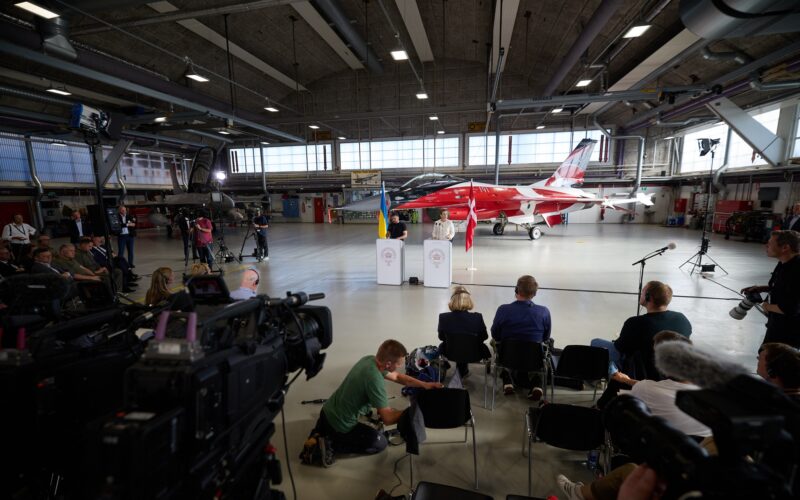After months of spearheading an international coalition to supply Ukraine with US-designed F-16 fighter jets, Denmark and the Netherlands have both officially pledged to deliver their respective fleet.
This commitment comes days after the United States gave its formal approval for Denmark and the Netherlands to transfer F-16 fighter jets to Ukraine.
The announcements were made during a visit by Ukrainian President Volodymyr Zelenskyy to the Netherlands and Denmark on August 20 and 21, 2023.
“In light of Russia’s brutal and unprovoked aggression, Denmark and the Netherlands, supported by the US, share the conviction that continued support to Ukraine is of utmost importance,” the governments of both countries said in a joint statement. “We agree to transfer F-16 aircraft to Ukraine and the Ukrainian Air Force in close cooperation with the U.S. and other partners, when the conditions for such a transfer are met. Conditions include, but are not limited to, successfully selected, tested and trained Ukrainian F-16 personnel as well as necessary authorizations, infrastructure and logistics.”
Copenhagen will supply a total of 19 F-16 fighters to Kyiv, Denmark’s Prime Minister Mette Frederiksen said, with six to be delivered around January 2024. In late June 2023, the Royal Danish Air Force (RDAF), known as the Flyvevåbnet, announced that it would retire its fleet of F-16 fighter jets from service as early as 2024 or 2025, contrary to an existing plan to keep them operational until 2027, to make them available to Ukraine.
The Netherlands did not specify how many aircraft would be supplied, with Dutch Prime Minister Mark Rutte only stating that the country has a fleet of 42 F-16s. The Dutch Air Force previously planned to continue flying the F-16 until the end of 2024 to conduct Quick Reaction Alert (QRA) missions.
“Another step to bolster Ukraine’s sky shield is F-16s,” Zelenskyy said. “We will use these jets to keep Russian terrorists away from Ukrainian cities and villages.”
Ukrainian pilots will not be trained before 2024
The timeline for delivery depends on the training of the Ukrainian pilots and technicians designated for operating and servicing the aircraft. In an online meeting with the Defense Writers Group, General James Hecker, commander of US Air Forces in Europe, US Air Forces Africa, and NATO Allied Command, clarified the training situation.
A pool of 32 Ukrainian pilots was selected, out of which eight were found to possess the necessary English proficiency to begin training. The remainder will receive terminology lessons in the United Kingdom. The selected cadets are young, with Ukraine keeping its most experienced pilots on the frontlines.
“Then they’re going to get a little bit more training on propellers, and then go down to France and fly in the Alpha Jet for a little bit,” Hecker said, as reported by the Air & Space Forces Magazine.
Popularly referred to as the “Gadget” in France, the Alpha Jet, also known as Alphajet, stands as a dual-seater twin-jet aircraft created collaboratively by Dassault Aviation and Breguet. Originally conceived for both training and close air support, this aircraft emerged from a collaborative effort between France and Germany. Operating since 1979, it has been a cornerstone of the French Air Force’s pilot training, taking over the role from the Fouga CM.170 Magister.
The French Air and Space Force recently retired its Alpha Jet E jet trainer fleet, transitioning to the Swiss-made Pilatus PC-21. Around 30 Alpha Jets were mothballed, while 53 were kept to fulfill the role of “aggressor” during adversary training and to be flown by the Patrouille de France, the country’s main military aerobatic team.
The final six fighter pilots to train on the Alpha Jet were promoted on March 16, 2023, with the Côte d’Or Training Squadron in Cazaux, near Bordeaux. The facility is likely to undertake the advanced training of Ukrainian pilots in the future.
The pilots will then move on to receive basic training on the F-16, also known as B-Course. Denmark has been selected as the initial training location for Ukrainian personnel on the F-16 until the construction of a dedicated training center in Romania is completed. According to Hecker, the first Ukrainian pilots will not be ready to fly the F-16 fighter before early 2024.
What F-16 variant will Denmark and the Netherlands be supplying to Ukraine?
Denmark and the Netherlands will be providing F-16A/B Block 20 MLU (Mid-Life Update) variants that represent late iterations of the 45-year-old fighter jet. These aircraft were modernized through the MLU program between 2003 and 2005 with enhanced avionics, improved radar systems, and upgraded weaponry. With radars such as the APG66 and missiles like the AIM-120 with a range of up to 150 kilometers, they ensure formidable air superiority.
The F-16 MLU features a Head-Up Display (HUD) compatible with night operations, a GPS receiver, and a Westinghouse (now Northrop Grumman) AN/APG-66 fire control radar allowing it to carry and fire six AIM-120 AMRAAM air-to-air missiles, with an operational range of 150 kilometers (95 miles). It can drop guided bombs such as the GBU-24 Paveway III or the Joint Direct Attack Munitions (JDAM). This variant of the fighter also possesses the capability to carry Sniper and Litening targeting pods.
These F-16 fighters will have the capacity to deploy a wide array of bombs and missiles, making them adaptable to various mission profiles for Ukraine. However, these missions will be limited by the training received by pilots.
“You can get proficient on some weapons systems fairly quickly. But ones like F-16s, it takes a while to build,” Hecker explained, adding that fielding a few F-16 squadrons with a high enough state of readiness could take four to five years.
As such, their role could initially be limited to defending Kyiv and other large Ukrainian cities from Russia’s cruise missiles such as the 3M54 Kalibr and the Kh-22, or the Iran-made Shahed-136 kamikaze drones.

